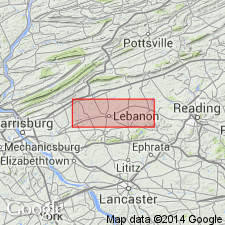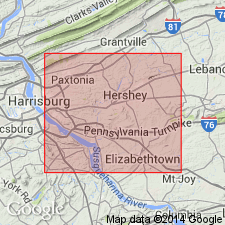
- Usage in publication:
-
- Myerstown limestone
- Modifications:
-
- Named
- Dominant lithology:
-
- Limestone
- Metabentonite
- AAPG geologic province:
-
- Appalachian basin
Summary:
Named the Myerstown limestone in southeastern PA [probably for Myerstown, Lebanon Co.]. Typically consists of dark-blue to black, dense, thin-bedded, graphitic limestone with occasional beds of calcarenite. Contains three or four metabentonites. Weathered outcrops frequently show fluted edges similar to fluting of underlying Annville limestone. Maximum thickness is about 200 feet. Contact with Annville marked by one or more beds of black very graphitic shaly limestone succeeded by varying thickness of impure gray crystalline limestone; these beds grade upward into the Myerstown. Underlies Hershey limestone which is less pure and darker in color. Unit was previously included in Leesport formation. The Myerstown is of Middle Ordovician age.
Source: GNU records (USGS DDS-6; Reston GNULEX).

- Usage in publication:
-
- Myerstown Formation
- Modifications:
-
- Revised
- AAPG geologic province:
-
- Appalachian basin
Summary:
Revised the Myerstown to the Myerstown Formation. Consists of thin, regularly bedded, medium-dark- to dark-gray, fine-grained, dense limestone which weathers medium to medium light gray with a distinct bluish cast. Basal beds have a shaly appearance, are very dark gray and carbonaceous. Several metabentonites occur in the formation. Thickness is between 200 and 250 feet. Overlies Annville Formation and underlies the Hershey Formation.
Source: GNU records (USGS DDS-6; Reston GNULEX).
For more information, please contact Nancy Stamm, Geologic Names Committee Secretary.
Asterisk (*) indicates published by U.S. Geological Survey authors.
"No current usage" (†) implies that a name has been abandoned or has fallen into disuse. Former usage and, if known, replacement name given in parentheses ( ).
Slash (/) indicates name conflicts with nomenclatural guidelines (CSN, 1933; ACSN, 1961, 1970; NACSN, 1983, 2005, 2021). May be explained within brackets ([ ]).

